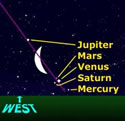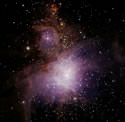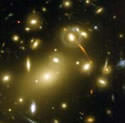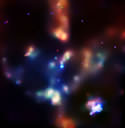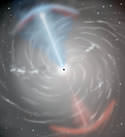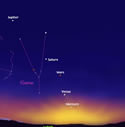
Image credit: Harvard
During late April and May you’ll get an opportunity to see the five brightest planets lined up in a single evening. Look West in the early evening sky and you’ll be able to see Mercury, Venus, Mars, Jupiter, and Saturn grouped up. The grouping is fairly rare and won’t be seen again until 2040.
Comet Hale-Bopp dazzled us for weeks. The Perseid meteor shower thrilled us for one night. But the world hasn’t seen anything like the planetary traffic jam that’s going to occur the last week of April and the first two weeks in May!
Inching across the sky like bumper-to-bumper commuters on their way to work, a rare planetary alignment will allow sky observers to see every planet in our solar system in a single evening! “There will be other opportunities in the future to see the planets in different configurations,” says Philip Sadler, Director of the Science Education Department at the Harvard-Smithsonian Center for Astrophysics (CfA) in Cambridge, MA, ” but it won’t be anything like this for at least another 70 years. This is truly a once-in-a-lifetime experience.”
In the past, many different configurations of planetary alignments have been seen from Earth. They occur due to the random positions of the planets in their eccentric orbits around the Sun. In the early 1980s and in May of 2000, the planets stacked up directly behind the Sun. Many people thought the combined gravitational pull might create havoc here on Earth resulting in giant earthquakes, sweeping tidal waves or erupting volcanoes. But, the collective gravitational pull was so insignificant, nothing happened. What was the reason? The other planets are simply too small or too far away in space to affect us back on Earth. To see just how insignificant the gravitational pull of the planets can be, let’s do what many good, red-blooded Americans like to do. Let’s go shopping!
Imagine if we stood in the produce section of a grocery store and held up a big yellow grapefruit representing the Sun. The planet Mercury would be the size of a small grain of salt orbiting around it 18 feet away. Venus would be somewhat larger, like a grain of sugar you get in those little brown packets at the coffee shops, 34 feet away. Earth, also a grain of sugar, would be located 50 feet away. Mars also would be the size of a grain of salt 75 feet away. As for the rest of the planets: Jupiter, a cherry-sized tomato, would be found at 240 feet; Saturn, the size of a green grape, at 420 feet; Uranus, a frozen green pea, at 300 yards; Neptune, also the size of a frozen pea, at 470 yards; and Pluto, represented by a speck of dust, would orbit our grapefruit-sized Sun at a distance of 475-600 yards. As you’ve probably guessed, not much gravitational pull is exerted on the Earth by these grocery store lightweights!
In early May, when the planets line up, they will not be arranged behind one another or the Sun. Instead, they will present a beautiful line across the sky from horizon to near zenith. For a period of a little more than three weeks, anyone looking west at sunset will be able to see the planets Mercury, Venus, Mars, Saturn and Jupiter. A few hours later at 4 A.M., armed with a large-size amateur telescope, they can continue their grand tour by observing Uranus, Neptune, and Pluto. By quickly glancing down at the ground, they will have completed their grand tour of the solar system.
Looking at the planets spread out across the sky during this alignment also demonstrates, better than any book, how our solar system formed 4 billion years ago; something astronomers just recently have begun seeing around other distant stars in space. “Our solar system condensed out of a nebular dust cloud that flattened down into a giant disk that resembled a big pizza pan,” says CfA astrophysicist David Wilner. “Utilizing instruments like the Hubble Space Telescope and data from the Infrared Astronomical Satellite, we are now witnessing the formation of new solar systems spread out into flattened discs of gas and dust. We are even detecting large lumps of material in the dust disks that may be the signatures of planets in formation. Astronomers are now assembling snapshots of our own past frozen in time billions of years ago.”
This pathway of planets, or the ecliptic as astronomers call it, is what remains after our dust cloud coalesced into planets. Tracing the path of this ancient dust ring across the sky is easy. Stand sideways facing south with your right hand extended and pointing to where the Sun recently set along the western horizon. Now, extend your arm up to point at the Moon or a bright planet overhead. Connecting these two points together, continue to sweep your arm in an arc until it reaches the opposite horizon. Bingo! You have just traced out the ecliptic. All the planets will be found along this line and nowhere else. And this is where the traffic jam will occur.
“Coincidentally,” says Sadler,” have you ever wondered why the zodiac sign were chosen? Why someone you know wasn’t born under the sign of Hercules or Orion?”
To the Greeks and Romans, the ecliptic was the Highway of the Gods or the path the planets and Moon moved across at night and the Sun traveled during the daytime. “Located directly behind this highway were the twelve special constellations the Gods passed by as they moved across the sky. They constituted the signs of the zodiac. This was the basis for astrology – religious beliefs and basic sky observations mixed together. It should not be confused with the science of astronomy that emerged centuries later,” says Sadler. Today, it is widely held by many historians and planetarium directors that a conjunction of the planets, similar to the one on May 5, accounts for the Star of Bethlehem that sent the Magi on their way to seek the Christ child. Certainly the timing was right. An almost identical triangular alignment of Saturn, Mars and Venus did take place on April 1, 2 B.C. And the planets Jupiter, Saturn and Mars also formed a triangular conjunction in 6 B.C., in the constellation Pisces, the sign of the Christians. However, renowned astronomical historian Prof. Owen Gingerich of the CfA disagrees. “The very, very short duration of a grouping of planets was not the Star of Bethlehem,” he states. “A conjugation like this would have meant nothing to the Magi. It was not part of their astrological tradition. It really wasn’t until Kepler became fascinated with the harmony of the planets in the 16th century that the idea of a planetary conjunction came about to try to attach a scientific explanation to this event. In fact, Kepler even went so far as to add an imaginary supernova to the conjunction of planets in 6 B.C. to try to make it even more spectacular to catch the Magi’s attention. ”
Will this event be religiously significant or just an astronomical oddity? Is it the most dramatic way to visualize how our solar system formed? Or, is it an exciting challenge for amateur astronomers to conduct their only whirlwind tour of the solar system in just one evening? Answering yes to any or all of the above makes the alignment of late April and early May something not to be missed. Nothing like it will occur again in our lifetime. At the very least, it presents a wonderful opportunity for friends and family to come together and share an experience beyond the daily routine. It also may be an opportunity to ponder our fragile existence on this tiny blue world racing around an ordinary yellow star with eight other planetary companions and maybe help us, just a little bit, bring our own world back into perspective.
Headquartered in Cambridge, Massachusetts, the Harvard-Smithsonian Center for Astrophysics (CfA) is a joint collaboration between the Smithsonian Astrophysical Observatory and the Harvard College Observatory. CfA scientists organized into seven research divisions study the origin, evolution, and ultimate fate of the universe.
Original Source: CfA News Release
